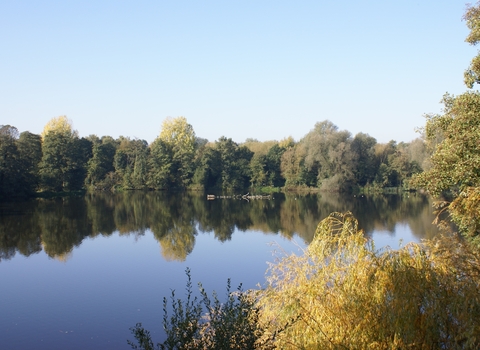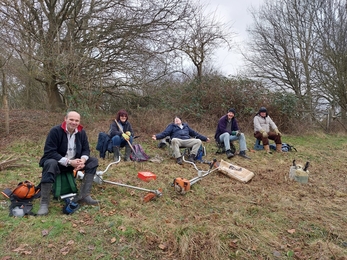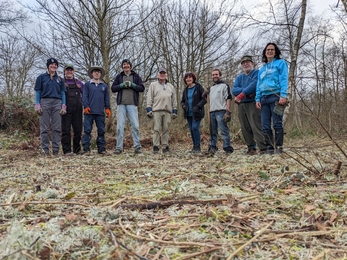Update from Susan Mckelvey, Sevenoaks Volunteer Trainee Warden and Sevenoaks Greensand Commons Assistant Project Officer
Time is flying, and this is my penultimate update from Ruth & I, the Sevenoaks trainees.
At the beginning of February we completed our chainsaw course, as a group of 4 women - a rarity our trainer admitted. We had a brilliant week full of learning, coffee drinking, cake eating (so much cake!) & had time to put the world to rights in between, and then the storm soon after gave us the opportunity for supervised practice cross cutting.
We have had a go towing & reversing with a trailer (in the safety of the yard), something Ruth was a natural at, and after returning from repair, we had the chance to use the BSC mower, supervised by an experienced volunteer. We learnt it is loud, has too many levers & drives like a tank & 'never put it in 4th gear' (oh how tempting!).
We are looking forward to the next couple of months & the things we will learn, as well as feeling sad it will end. I am happy to announce I will be hanging around KWT a bit longer as I have started working with the Greensand Commons Project as an assistant project officer, working 2 days a week. I am very excited to see all the sites, meet all the people and volunteers involved and get stuck in.
Update from Ruth, Darenth Area Volunteer Trainee
I am pleased to inform our readers that as the Sevenoaks trainees have now been let loose with the volunteers on several occasions, all volunteers (and trainees) still have all the fingers, toes, noses, ears, wits and sanity that they started with. We have run tasks at Cowden Pound, removing invasive bramble and bracken with brushcutters in order to help native neutral grassland plants such as glaucous sedge, devil’s-bit scabious, eyebright and green-winged orchids to thrive. This in turn supports other organisms such as pollinating insects and ground nesting birds. The volunteers worked tirelessly at Cowden to clear large swathes of the monstrous bramble that had taken over the pastures (whilst also further refining our raking skills, of course), however the hilly terrain did try to get the better of us all, and homemade cakes eaten in the sunshine were an absolute necessity.
The trainees have also been learning to write up management plans - mapping out what work needs to be done, determining how and when it should be done, and planning and leading task days to carry out this work. This project has been taking place in the goat paddocks at SWR, clearing invasive plants including buddleia and brambles in order to create a suitable environment for forest school activities. The first of these tasks was held on a Saturday in January, where we had an excellent turn out from both volunteers and sunshine, and masses of buddleia were removed with tree poppers (yippee no raking!). We are looking forward to leading more tasks at Cowden Pound and in the goat paddocks during the last two months of our traineeship, and learning as much as we can from the staff and volunteers we work with.
Queendown Hedge experiment update
Last summer, the Queendown Team laid the foundations for a small experiment in establishing a hedge or copse. We started by repairing the fence between Hay and Thistle fields, and then running a parallel fence line stood 3m off the original, this gave us a nice channel of about 200m long to play with. This channel has then be subdivided into 4 sections of 50m long by marking out posts, with each section to have a different method trialed.
Section 1 Starting at the top of the fields by the woods will be natural regeneration/colonisation, we are going to leave it to do its own thing and see what seeds and suckers in from the adjacent woodland, and potentially the neighbouring section.
Section 2 is the most traditional with whips of various species planted, in order to try and improve hedge diversity across the reserve a non standard mix was used (Blackthorn, Hawthorn as the base with; Hazel, Field Maple, Buckthorn, Briar Rose, Guelder Rose, Wild Plum, Crabapple, Wych Elm and Goat Willow). However, contrary to standard procedure we have not used any tree guards (we are fortunate to have no deer in the local area). These in my experience are a pain to remove in a few years time and also limit the branching of the young trees, ensuring if you bend over you can see straight through the hedge from one side to another as the guards effectively crown lift the plants 2 ft off the ground. The whips will be monitored and if there is a significant loss we will rabbit fence that 50m section, hopefully it won’t come to that. That section was then bookended with two trees which will be left to become standards within the hedge/copse and have been protected with rabbit netting, these are a Pendunculate Oak and a disease resistant Elm (Ulmus x wingham/Ulmus FL493).
Section 3 is to be a new trial where scrub/hedging plant material is cut in winter and any material containing fruits and seeds still on the plant is to be taken over to the section and run through the chipper. This material it is hoped will act as a bit of a light mulch, but that the seeds and fruits will be small enough to pass through the chipper and then hopefully germinate. This is delayed at the moment due to catching up with other winter work missed in previous COVID hit seasons, therefore any future monitoring will take into account that this section is a year behind the rest.
Section 4 is to be a similar approach to section 3 bar that the material will not be chipped but rather has been stacked into a loose dead hedge, with the idea that the thorns on the plant material will form an impenetrable barrier to grazers like rabbits as well as provide lots of perching points for birds. The idea being then that the fruits and seeds drop from the cut material onto the ground below and germinate, these young plants will then be protected while they establish by the thorny material they grow through.
This is all not overly scientific due to the number of sections, mistiming for the starting of some sections (Section 3) and the fact it is only on one small area of the reserve. However, hopefully it will act as a pilot study and proof of concept for implementation on a larger scale if future funding is acquired. The planting of an Elm may also have raised a few eyebrows, however this particular strain has shown great success in studies on Dutch Elm with a defoliation rate of 1.44% and a dieback rate of 0%, with Queendown badly hit by Ash Dieback disease resistant Elms may well be an answer to some of those lost landscape trees, and again depending upon future funding we hope to plant more.








